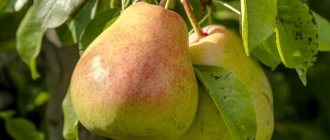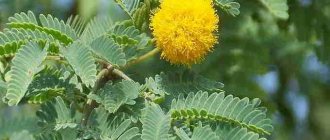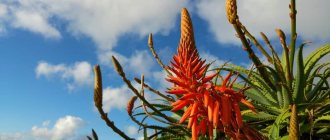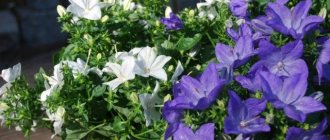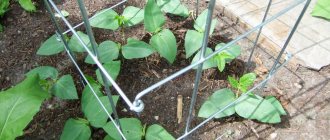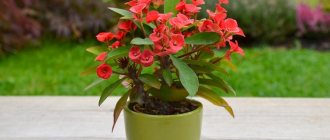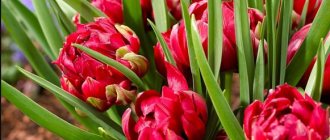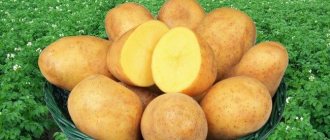Mimosa or Mimosa belongs to a genus of flowering plants from the legume family or Fabaceae. Until recently, Mimosa belonged to the disbanded family Mimosa or Mimosaceae. Mimosas can be represented by herbs, shrubs or medium-sized trees with bipinnate leaves.
Most often, the flower consists of four parts, but there are species with three or six parts. The inflorescences are represented by dense heads or racemes. The predominant place of growth is South America. More than 600 species are known and studied.
Main types
Shy or Mimosa pudica L
Prefers damp places and thickets. The main habitats are the lowlands of the Antilles and the territory of Brazil. The appearance corresponds to evergreen plants, subshrubs or shrubs with straight shoots up to one meter high. Characterized by the presence of spines and pubescence.
Small flowers are collected in heads at the top of the shoots. The predominant color is pink-violet. Flowering - in summer. Grown as an annual ornamental plant.
Rough or Mimosa scabrella
The birthplace of this twenty-meter plant is South America. The panicles of numerous flowers are painted white.
Photo gallery
Lazy or Mimosa pigra
An amazing perennial ornamental plant. Straight and branched shoots reach a height of 0.5 meters. White flowers are characterized by spherical heads. Fern-like leaves are highly sensitive.
General overview
Externally, this cute and quivering flower looks like a small shrub, no more than 40 cm in height, although in natural growing conditions it reaches 1.5 meters.
The bush has small pink and lilac inflorescences in the shape of miniature balls, which bloom for four months, from the first days of summer to the last days of September.
Feather-shaped double-sided leaves adorn the straight stem, lightly covered with small spines. In this case, the entire flower is covered with a light fleecy edge.
As you can see, the bashful mimosa is significantly different from the yellow mimosa flowers, which are usually given as gifts on March 8th.
In its natural environment, mimosa is a perennial plant, but at home it is grown as an annual. Pollination of inflorescences occurs due to insects and wind. As a result, the flower bears fruit in the form of pods, inside of which there are beans.
An interesting fact is that at the slightest touch, the mimosa folds its leaves and lowers them down, which is why it is called bashful.
When the wind blows, the same effect is observed. And only after 30 minutes. the leaves return to their previous shape, but only if the irritants are eliminated. In addition, the leaves fold according to the flower's personal pattern every 22 hours.
Mimosa propagation
- Seeds are often used for propagation, but mimosa cuttings can also be rooted. At the beginning of March, the seeds should be scarified, which is carried out according to certain rules, or doused with boiling water.
- Sowing of treated seeds is carried out in a substrate, which consists of two parts peat and part river sand.
- The planting depth of mimosa should not exceed 5 mm. Seeds germinate at a temperature of +25°C.
- Picking is done after two or three true leaves appear.
- The soil needs regular moistening.
Why do the leaves of Mimosa pudica close?
When force, such as touch, is applied to mimosa leaves, the plant's leaf cells lose turgor pressure—the internal pressure of the cell. This occurs due to the release of chemicals, including potassium, which removes water from the cells. As soon as a leaf is deprived of water, it droops. This feature is also found in other plants of the Mimosa genus.
It is not known exactly why the bashful mimosa developed this property. Scientists suggest that it appeared to repel herbivores or insect pests.
We have our own “northern bashful mimosa” - this is wood sorrel (Oxalis), or hare cabbage, common in the forests. The amazing property of this plant is to fold its leaves under the influence of irritation (seismonasty). Oxalis folds its leaves in the evening (nyctinasty). Oxalis leaves curl when the sun's rays fall on them (photonasty). If the wood sorrel is placed in strong sunlight, it will fold its leaves before our eyes within 3-5 minutes. If you then put it in the shade, it will open its leaves, but not soon, but after 40-50 minutes.
I look forward to your feedback about this small, modest, but interesting flower.
Landing Features
In our climate zone, mimosa is grown in greenhouses and winter gardens. The plant is very heat-loving and light-loving. It is able to form a compact bush and bloom profusely only in the presence of bright sunlight.
The ideal landing location is the south side. To protect against sunburn, the tender leaves of mimosa are shaded, and after cloudy days they are gradually accustomed to bright light. Mimosa is characterized by relatively slow development and weak height gain.
The optimal soil for planting is a mixture of topsoil, peat, prepared humus and sand. All ingredients are taken in equal quantities. The bottom of the container must be equipped with drainage, which can be expanded clay.
In which climate does it grow best?
The question of where mimosa grows becomes relevant not only on the Eighth of March; it is asked by gardeners who love this amazing plant. Initially, it grew only on the island of Tasmania. Gradually, the tree moved to nearby countries, and from there it reached Russia.
The natural climate for the plant is warm and high humidity. In the Australian heat, mimosa grows to the size of a full-fledged tree, but in regions where it is not so hot, it stops at the size of a shrub.
Care Tips
- Mimosa prefers regular watering with soft and settled water. The signal for the next watering is the relative drying of the top layer of soil. The plant requires the most abundant moisture from spring to early autumn. Then watering is reduced, and by winter they move to a level of very moderate moisture.
- Mimosa is very sensitive to dry indoor air and responds positively to spraying with soft water.
- Feeding is carried out in spring and summer regularly twice a month. Fertilizers are not used in winter.
Description
Now that we have found out where mimosa grows, we should give this plant a brief description. Only general information will be given here, and the specifics are given in the descriptions of the various types. These include:
1. The entire crown, which is very spreading, is formed from brown shoots that have small cracks.
2. Mimosa leaves have a dissected shape, and the trunk is very prickly.
3. The flowering period for this plant is from mid-January to mid-April. During this period, a large number of small yellow flowers appear, which are collected in balls. Over time, they turn into inflorescences, united into brushes.
Diseases and pests
- Excess moisture and overwatering cause yellowing of leaves.
- Irregular and insufficient watering can cause leaves to fall off.
- With a lack of light, plant stems tend to stretch and lose strength.
- Low temperatures affect flowering.
- Mimosa is most often affected by aphids and spider mites.
Light and location
If you decide to grow a bashful mimosa yourself, you need to carefully choose the place for its location. The best option would be a place that is in direct sunlight, so at home it would be best to place the pot on the south side. Of course, in the summer at the peak of the sun, it will be best to remove the pot with the plant for a couple of hours in the shade, but in general, mimosa responds very well to bright light. After winter, it is best to gradually accustom your shrub to the sun, as this will help avoid leaf scorch.
Application in landscape design
Any floral arrangements in landscape design must correspond to the general idea. In everyday life, mimosa is often confused with certain types of acacias belonging to another genus from the Mimosa subfamily. Mimosa and acacia are surprisingly similar in appearance.
Most often, instead of mimosa, silver acacia or Acacia dealbata is used in decoration. Twigs of this particular flowering plant are traditionally given as gifts on International Women's Day.
Mimosa pudica or touch-me-not can be easily distinguished by touching it with your hand. The response to such a mechanical effect is the folding of all the leaves. The leaves can open only after half an hour or an hour. This protective property is a sure sign of mimosa.
Regions of growth in the Russian Federation
You can find a small mimosa in Russia on the Black Sea coast. In the local climate, it grows only up to 12 meters and is a shrub.
The shrub grows in regions such as Sochi, the Caucasus, and Abkhazia.
Initially in Russia it was a cultivated ornamental plant decorating parks and alleys, but now mimosa has spread so much that it has become a wild weed.
In the world it is found on the island of Madagascar, in France, Montenegro, on the west coast of America and in Brazil.
Home care rules
Before planting a houseplant at home, you should know how decorative mimosa grows and how to properly care for it.
Lighting and temperature conditions
Mimosa bashful - what kind of plant, everything about it
For proper growth, the shrub must be provided with sufficient light. It is best to place it on the south side of the house, and only in very hot weather should it be protected from direct exposure to sunlight.
Important! After the end of winter, so that the leaves do not get burned, the plant must be gradually accustomed to sunlight.
Active growth of the bush occurs from mid-spring to mid-autumn. At this time, he needs to maintain the room temperature at about +25 °C, and in winter during the rest period it is enough not lower than +18 °C.
Mimosa is a flower that is afraid of cold and drafts, so it is recommended to take it out of the room during ventilation.
Watering rules and humidity
A tropical dweller needs a large amount of water. It is necessary to water the indoor flower twice a day - morning and evening. In winter, the amount of moisture can be reduced, but the soil should not be allowed to dry out completely. Water should be used that has settled, at room temperature, without impurities and chlorine.
To ensure sufficient humidity conditions during the flowering period, the leaves need to be sprayed with a spray bottle. In this case, you need to make sure that water does not get on the flowers. You can place a tray of water next to the pot.
Fertilizing and soil quality
Mimosa is a plant that requires medium acidity or slightly acidic soil for active growth. You can purchase it in a store or make it yourself by mixing the following components in equal proportions:
- river sand;
- turf;
- leaf humus or peat.
In addition to the soil, an important component of proper care is regular feeding. Fertilizers must be applied during the growing season from early spring to late summer. This is done every 12-14 days.
Flower container size
To plant a young bush, choose a container that is not too large - 15 cm in diameter is enough. Then, when transplanting, the volume of the pot increases by several centimeters each time.
Pruning and replanting
In order to preserve the decorative appearance of the plant, it is necessary to trim the tops of the main shoots. This should be done before flowering begins and after it ends. However, this should be done carefully. If you overdo it, the mimosa may die.
The bush should be replanted after winter, when it becomes cramped in the pot. To do this, take a larger container and use the same soil as during the previous planting. After completing the procedure, the plant must be watered abundantly.
Important! It is not allowed to replant in winter.
Growing in open ground
It will be quite difficult to grow mimosa in the garden, and this can only be done in the south of Russia in several regions where the winter temperature does not drop below 10 degrees, otherwise the plant will simply freeze. The plant is planted in loose soil on the sunny side of the site, which is well protected from wind and drafts. After this, it should be constantly watered until it becomes clear that the bush has completely taken root. There is no need to trim the branches: once the plant has taken root, it will require minimal care, provided that the climatic conditions are suitable.
Possible growing problems
Mimosa is a delicate and capricious flower. Problems often arise during cultivation. Most of them are easily eliminated by adjusting care and maintenance.
| Problem | Cause | Remedy |
| Rolling leaves | Reaction to smoke, draft, fumes. | Find a comfortable place for the flower. |
| Yellowish tint, lethargy, leaf drop | Lack of moisture in the soil or air. | Normalize the watering regime, spray the plant more often. |
| The leaves are constantly in a closed position | Excessive soil dampness, heat or cold in the room. | Check the condition of the soil. If it is too wet, limit watering for a while. Create favorable temperature conditions for the flower. |
| The stems are stretched | Lack of light. | If it is not possible to provide natural lighting, illumination with phytolamps is provided. |
| Mimosa doesn't bloom | The most likely cause is low air temperature below 16°C. | The flower is moved to a warm place and protected from cold drafts. |

